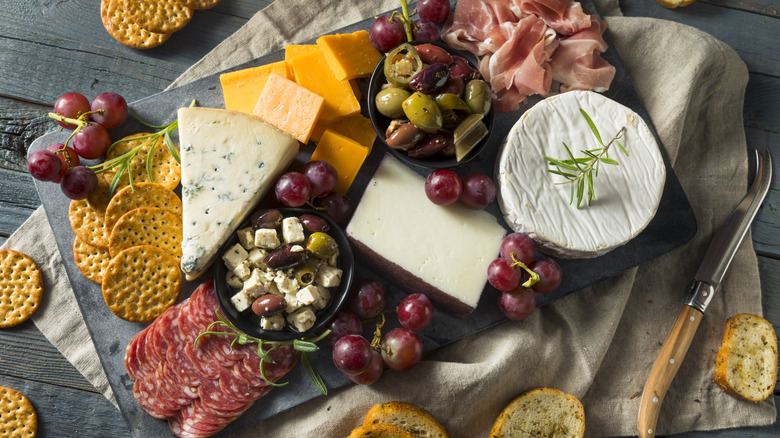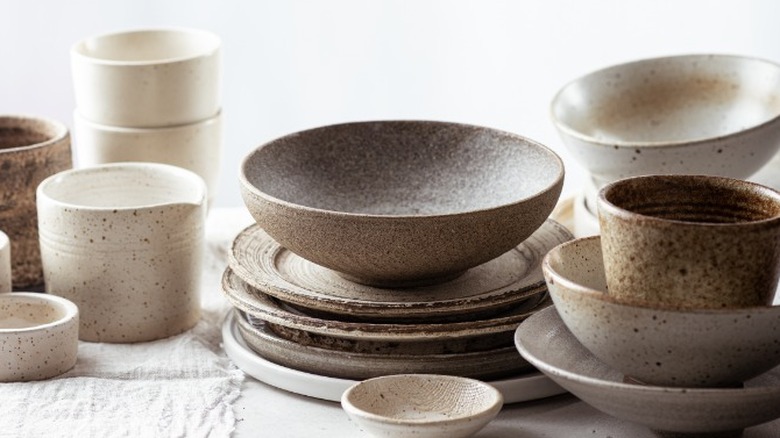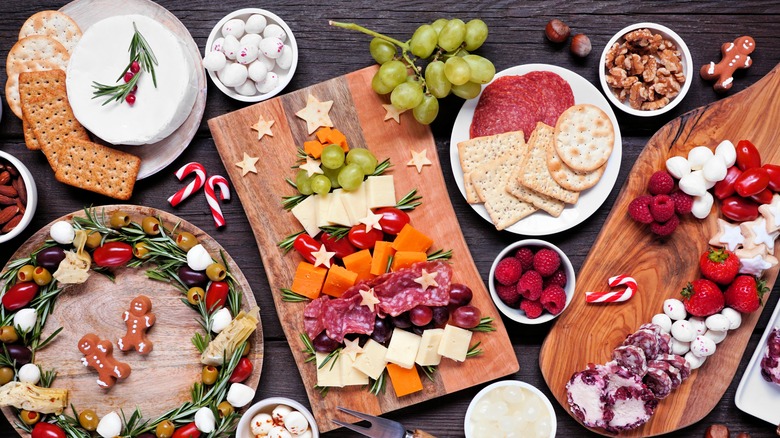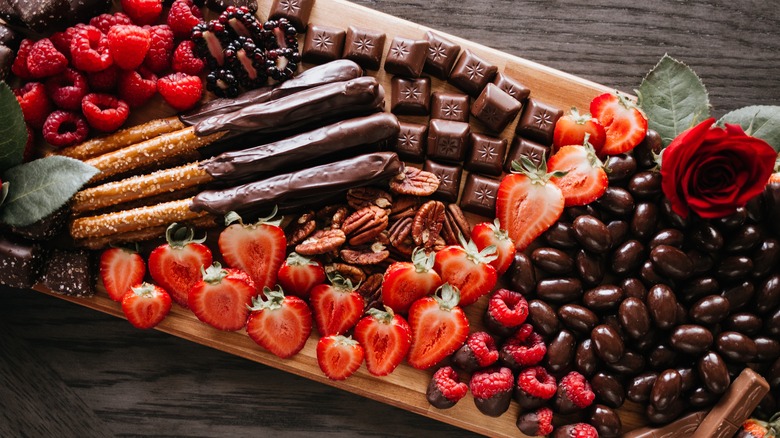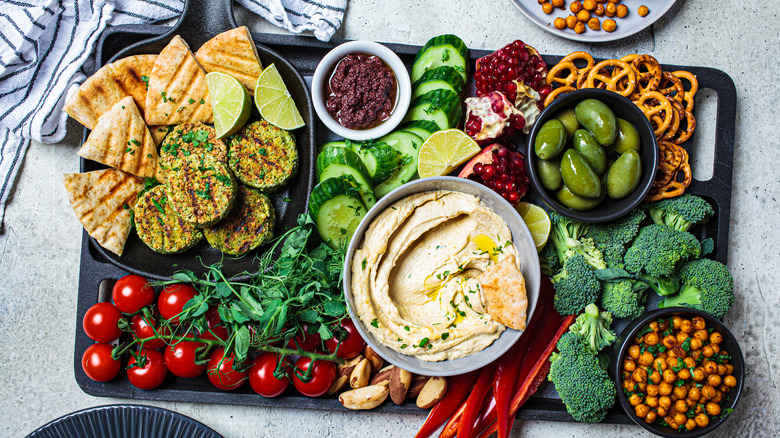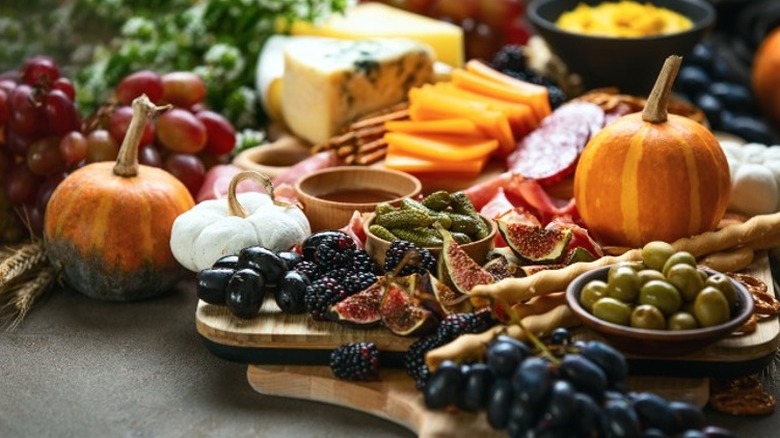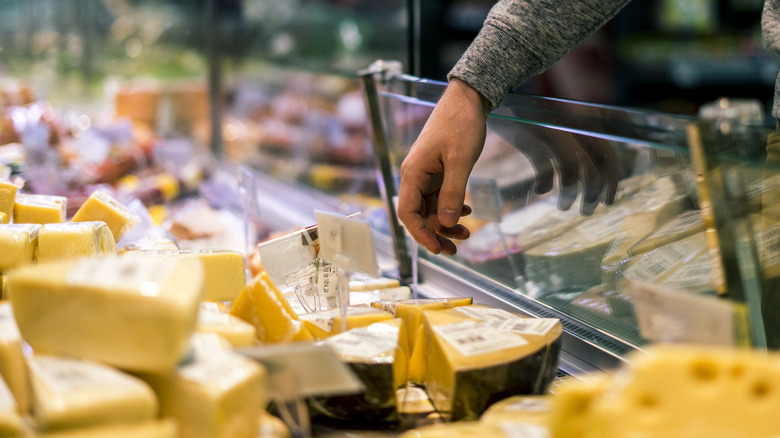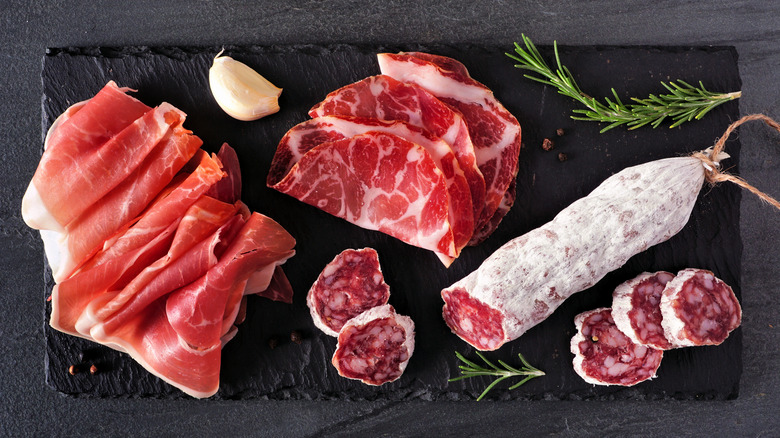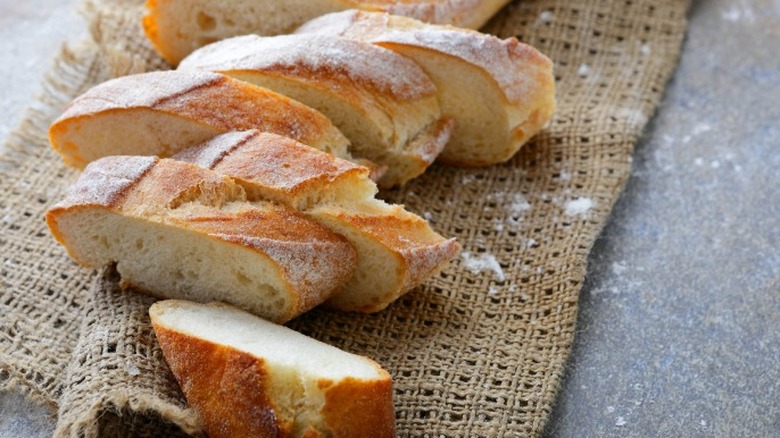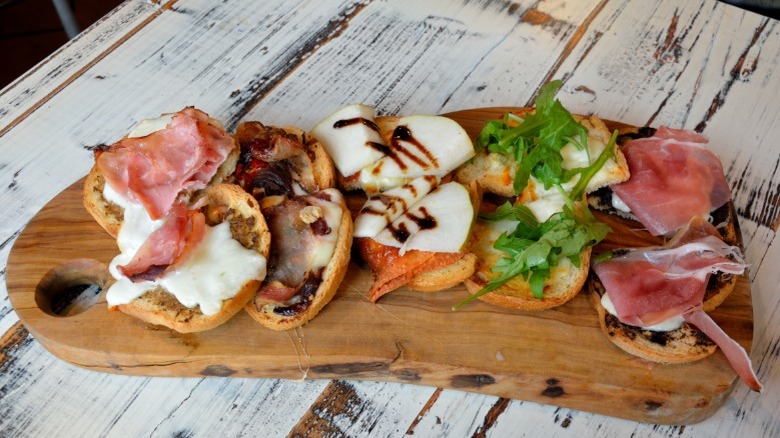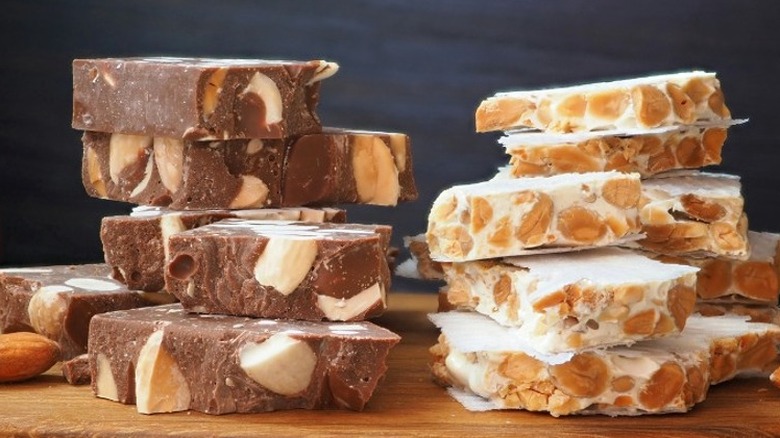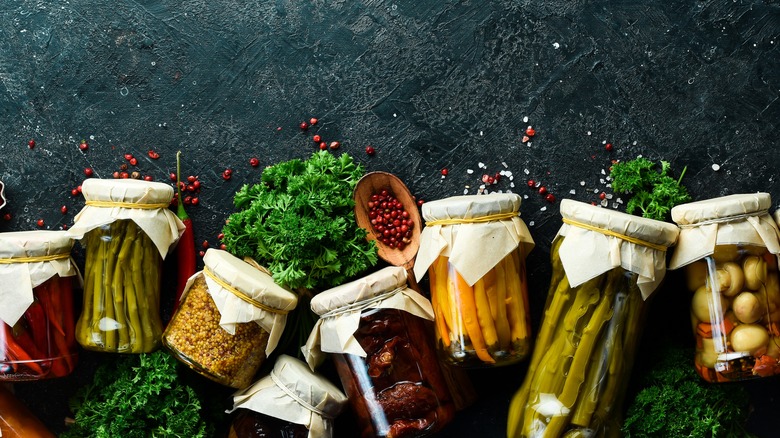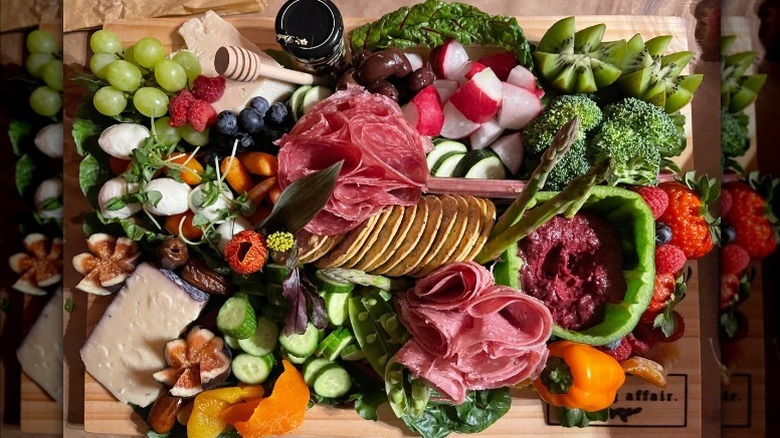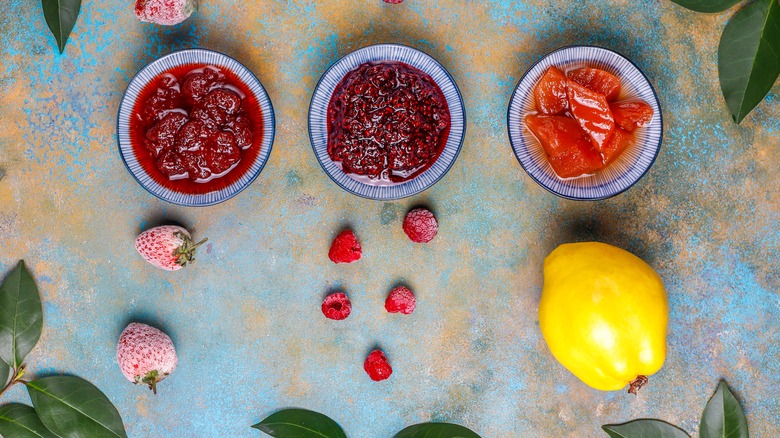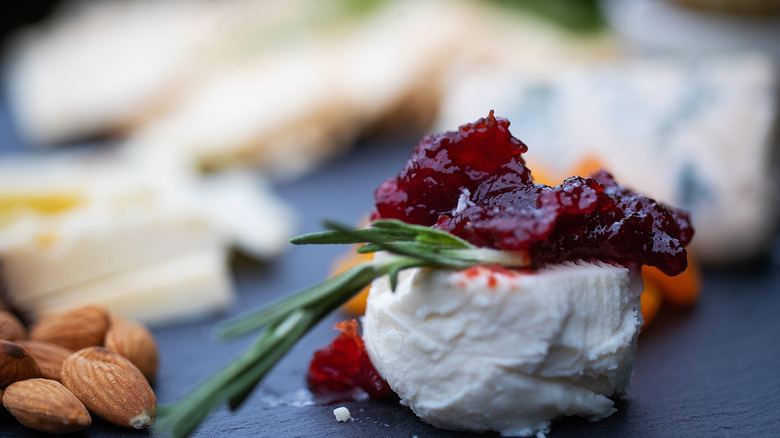The Ultimate Guide To Building A Charcuterie Board
Charcuterie is still a big deal — no party is complete without a few wooden boards covered with cured deli meats, a variety of cheeses, bowls of olives and pickles, and piles of crackers. Unless you're a professional charcutier (yes, there's a name for a person who makes charcuterie for a living), you might be looking for a few tips. First, let's look at what charcuterie is — and isn't. Originating in France, charcutiers started selling pork products in the 15th century (via Wisconsin Cheese). From there, the term charcuterie gradually came to mean the art of arranging cured meats and other delectable morsels that we know today.
Other branches of snacking are close ... but not quite charcuterie. For example, you might wonder, what's the difference between charcuterie and antipasti? They're quite similar but share important distinctions, including their region of origin. Antipasti come from Italy rather than France, and you can see that in the choice of ingredients used. This style is, roughly, Italy's version of appetizer and often includes lighter fare, including bruschetta or pickled vegetables called giardiniera (via Daily Italian Words). Whether you plan to be a purist in your style or make something with a mix of influence, your charcuterie board will only prosper by including these tips.
Start with your boards, bowls, and serving tools
You'll likely find arranging all your tasty bits and pieces easier if you've set the stage beforehand. Unless you're planning to serve something very minimalist (maybe charcuterie isn't for you, in that case), you might need to know why you should use two cutting boards for your charcuterie. There might be a few reasons to separate your items (food allergies or raw meats, for example), but it also just means more space for more food.
Pull out your biggest cutting boards, slate slabs, your cutest snack bowls, and anything else you think you'll need. Honestly, this might sound like a perfectionist talking but trust us — preparation is key and makes it much easier to refill during serving. Meat and cheese can be arranged right on the board, but you'll need all those little bowls for olives, pickles, or anything with loads of juice. Don't forget cocktail picks, serving spoons and forks, and napkins. Another helpful tip is to place condiments beside what you intend your guests to eat them with, brie with fruit chutney or comté with honey.
Consider the occasion
While it's not necessary to pull out a board for every elegant snack situation, there might be times when you want a little something extra to celebrate the occasion. Plan ahead; there are a lot of amazing ingredients for a patriotic-themed charcuterie board, and preparation can lead to wowing your guest on July 4th. Using patriotic colors in your serving ware, along with some red, white, and blue foods, will go a long way. You can also step it up with star shapes cut from a firm cheese or sliced meat.
Christmas is a time of year when we all have back-to-back events, and sometimes even the best hosts can run out of ideas. Some of must-have items for your Christmas charcuterie board include lots of red and green produce and garnishes, using cookie cutters to give hard cheeses some seasonal flair, or arranging your offerings into a wreath or tree shape. Maybe not as popular as Christmas, Easter charcuterie boards are on the rise and may just be the next social media trend — we're here for it. Peeps over cheese every day, baby.
Try a theme
Not celebrating a specific occasion but still want a little theme to base your board on? If you really love the food from a specific region, take that for a spin. Italy, France, Spain, Greece, and the United Kingdom all have an incredible range of delicious items that will also be pretty easy to find. But you can apply the flavors of any region you crave. You can try including things like red curry pork pâté, pho sausage, or a lemongrass and ginger terrine for a board that spans the globe.
Another trendy theme that you might not be able to resist (and why should you?) is a dessert board. A mixture of confections like brownies, cookies, chocolate bark, marshmallows, and a few nutritious options like fruit and nuts make this a sweet lover's dream. These boards are so decadent — and, honestly, gorgeous — that a version of the Trader Joe's dessert board has recently become eye candy for Redditors. Perfect for social media and sweet tooths alike. You can even theme your dessert board if you like — s'mores, ice cream, or donuts are all tasty ideas.
Check for dietary restrictions
The best thing about charcuterie boards is that they can offer something for everyone. If you want to ensure that you're feeding all your guests properly, give them a chance to tell you about any dietary restrictions beforehand. We don't mean run-of-the-mill choosey eaters; we're talking about vegans, people with food intolerances, and folks on preferred diets. Gluten- or lactose-free options are plentiful and have gotten exceptionally delectable in the last few years. If you check out some of these vegan cheese brands, you'll notice that you can cross off lactose-free and vegan simultaneously. Many deli meats are also lactose and gluten-free, too.
Guests with food intolerances should be considered to avoid any ingredients that pose a life-threatening hazard — there's always another opportunity to serve those peanuts. A little tip that your ingredient-avoidant guests will certainly value is ensuring there are designated bowls and serving utensils for allergen-free items. You can even use serving cards to identify items that may be troublesome to any of your guests.
Eat seasonally
While meat and cheese are generally timeless, the additions you pile onto your gorgeously arranged board should change according to the seasons. Depending on where you live, you might have a much better selection when choosing fruit and veggies, particularly in the dead of winter. While you can buy cherry tomatoes, grapes, or strawberries all year round, they might not be local (meaning they've traveled a long way to get to you), and they won't be at their peak of flavor. But even in the coldest months, building a charcuterie board can be done and done well.
So how do you make the best choices for local, peak season produce? This interview with David Tanis on how to get the most out of seasonal vegetables is a terrific place to start. Tanis calls those year-round tomatoes and strawberries "commodity vegetables" that will look stunning but won't have the flavor you're seeking. He's also adamant that even the most perfect in-season produce can occasionally still use a little pick-me-up. A dash of salt or a spritz of fresh lemon is never out of the question.
Choose the right selection of cheeses
On to the main event (for most of us) — meat and cheese. First, you're going to need to know your audience. Buying piles of unusual cheeses if your guests are more of the mild American slice and cream cheese types will just lead to disappointment all around. Don't discount those friends; instead, challenge yourself to incorporate a range of cheeses to appeal to everyone. Besides, mixing a variety of tastes and textures is a hard and fast charcuterie board cheese rule that every at-home charcutier should know.
Your selection of cheeses should include something aged with a strong flavor, like an older cheddar. Contrast that with something creamy, soft, and maybe a little mild — brie is always a terrific choice but feel free to branch out. Something that inhabits that in-between space, like Gruyère or Manchego, is another great category. Think of the cheeses that have a little bit of bounce to them, not too firm or too melty, and you've found a good middle ground. Blue cheese or a washed rind offering makes a delightful extra.
Consider your selection of meat
Just like you'll be considering the textures of your cheeses, you'll do well to apply that same focus to your selection of meat. Using the charcuterie board meat checklist, we suggest you incorporate textures that include cured, dried, spreadable, and a whole hunk that your guests can slice into. Dry-cured salami or Spanish chorizo is great for that. If you need some inspiration, consider these types of meat for your next charcuterie board, and then hit the deli counter of your nearest specialty shop.
In North America, we often stick to the tried-and-true cured meats on our charcuterie boards (charcuterie does mean cured meat, after all, according to Cork Dining). And while prosciutto, soppressata, and salami are absolutely close to our hearts, we should always be open to trying something new. Other cultures include canned or preserved fish on their boards. In fact, picada, an Argentinian charcuterie board, often involves the addition of tinned fish or octopus. Smoked salmon will give you some seriously Scandinavian vibes and pairs well with brie, tomatoes, or pickles. Truly, any good quality preserved fish will do here.
Add a variety of carbs
Carbs are an important ingredient for a truly balanced board — unless you're catering to all keto guests. Warm slices of baguette, toast points, or your favorite cracker will make a great pairing for everyone else you're serving. Keep in mind the charcuterie cracker rule you should never break ... your carbs shouldn't be overly flavored because they'll needlessly compete with everything else. Those incredibly overstuffed crackers full of cranberries, pistachios, sesame seeds, and everything else aren't going to play well with a pungent Trappist cheese. If you have your heart set on those, they do go exceeding well with camembert.
Think about water crackers, one of the most neutral pairing options for cheese. They have a lovely, light texture and not a ton of flavor. And they work perfectly. If that's too demure for you, there are loads of crackers out there, many of which still have good flavor (especially from sea salt or olive oil) without being overwhelming. If choosing the ideal cracker seems too intimidating, remember that almost no one ever turns their nose up at fresh bread.
Think about textures
To ensure you're serving an outstanding board, remember that you'll want to include a few different textural options, especially when picking your cheeses. Soft, medium, hard, crumbly, and runny options give you lots of room to choose from. Crunchy raw vegetables or pickles, spreadable chutneys or jam, crusty bread, and chewy slabs of salami all sound pretty good, instead of just hard cheddar and a handful of dry crackers. Adding different textures keeps everything interesting and balanced for your eaters.
While it's easy to find all sorts of textures in the cheese world, what about your meat selection? If you really want to experiment with your charcuterie, we suggest trying something like pâté or rillettes. Cretons — a staple Canadian food you need to try at least once — is a super-delicious French Canadian spread made from ground pork, spices, and breadcrumbs that also adds a new texture. If you're in a DIY mood, try making our chicken liver mousse with dill-pickled green beans. You'll be the hero of the snack set.
Don't forget something sweet
While you might find this hard to imagine, not everyone swoons for a table full of meat and cheese alone, no matter how many types you've stacked on it. Beyond just adding a bowl of fresh grapes, consider adding a few sweet treats, like dark chocolate, nougat, or torrone. Candied nuts can be a lovely touch, and luckily, we happen to have some great and easy methods for making candied pecans.
Dried fruit is a terrific option, as well. Satisfyingly sweet but still feels virtuous enough to have one more piece. If you struggle with keeping dried fruit supple, there are a few things you should know to do when your dried fruit is too hard, such as how to rehydrate them. Figs, apricots, and even crisp slices of dried apple can make a fantastic addition. We're partial to various types of date fruits as well. One of the reasons we like using dates on charcuterie boards so much is that the minerality of the sugar pairs exceedingly well with prosciutto and mild goat cheese (especially goat cheese infused with honey).
Go for something tangy
We also recommend filling a bowl or two with something pickled. The acidic nip of vinegar will bring another level of flavor to your spread, as well as being a pretty decent palate cleanser (think of gari, or pickled ginger, eaten with sushi). And honestly, most people love pickles. Some of us love them so much that we've honestly considered learning how to make a pickle board and just serving that instead.
If you're not about to give up all the meat and cheese (we hear you!), think about how adding some of the different types of pickled vegetables can accentuate different flavor profiles. Gherkins, red onions, and radishes can create sharper, more stringent tastes, while mushrooms give an earthier softness. On the other hand, pickled beets can add a slightly sweet note, especially good if you're short on sugary spreads. All of these options can taste superb when served with sharp or strong cheeses. For something unexpected, we think these pickled grapes can even warrant consideration. They are stunning to look at and retain much of their saccharine fruitiness while picking up a little bite from the vinegar.
Include brightly colored fruits and veggies
To add another tasty upgrade to your board, look no further than adding some fruit and veg. Cover the range of colors in the spectrum by adding cherry tomatoes, fresh sugar snap peas, or a handful of gorgeous radishes. Matchstick-cut heirloom carrots in shades of orange and purple make a brilliant addition, especially when you give up on peeling them and embrace the vibrant exteriors. Think of the fruits and vegetables you pair with your cheese and meat as just a bit of crudité — the raw veggie platter with the ubiquitous ranch dressing. But here, go a step further and add something far better, like our whipped feta dip recipe.
If you want to get a headstart on your prep, you can even start washing and chopping your produce beforehand. Knowing which produce storage mistakes to avoid will save you time and maybe even reduce your pre-party stress. Choosing veggies that people will actually eat (no more raw broccoli!) that are fresh and in season will make your charcuterie board a standout, as well as capitalizing on healthier nibbles.
Know what to sip with your board
We're not here to yuck your yum. You're free to drink whatever you like with your carefully planned charcuterie. However, if you want the best experience, there are some things to think about. In particular, you should think about the cheeses you've meticulously picked out, especially if you're serving wine. Many kinds of cheese pair beautifully with beer or a crisp cocktail. However, you probably shouldn't pair red wine with soft cheese because of the combination of tannins and acidity that don't play well with brie, gorgonzola, or Port Salut types of cheese.
Don't despair. Some combinations work exquisitely well together. Deep reds pair with hard, aged cheeses (like a strong cheddar), while those soft, young cheeses are a match made in heaven with a riesling or gewürztraminer, per Dairy Farmers of Canada. They say semi-soft cheeses can be partnered with a wide range of dry and light wines, from white to rosé to reds, making them a foolproof addition. Think Gouda, Fruilano,or provolone.
Remember to add condiments
For an extra touch, a couple of condiments won't go amiss. A simple pot of honey (for drizzling over soft cheeses, especially) is terrifically elegant, but there are loads of other options, too. For something with a little more prep (and pep, we dare say), you can try some Padma Lakshmi-approved chutneys. One is made from sweet plums, chipotle peppers in adobe, lemon juice, and olive oil. It's quick to concoct and has a gorgeous combination of sweet and spicy that you'll love. Lakshmi's other suggestion is a combination of caramelized onions, balsamic vinegar, and black pepper that gets cooked down until it's thick and rich.
An even quicker but still homemade option is the Giada De Laurentiis' quick jam trick, which has been known to elevate a cheeseboard or two. By simply taking a good jam and combining it with Calabrian chili paste and a squeeze of lemon, you've whipped up something elevated yet effortless. No fancy chili paste on hand? Make one yourself. It's basically a puréed combination of mildly spicy chili peppers, olive oil, garlic, and salt. Easy to do, and worth the effort.
Manage the leftovers with style
It would be easy for us just to tell you to stuff all those leftovers into a sandwich or cover a pizza with them. Don't get us wrong, that's absolutely delicious, but there has to be something better. Meat, cheese, and vegetables can always be reliably mixed with eggs to create a quiche or frittata. All those ingredients are also excellent for stuffing into butterflied chicken breasts and roasting.
What about olives and pickles? They'll last perfectly well put back into the fridge but if you're looking for a little upgrade, try making a classic tapenade. If you find yourself holding a jar of pickle brine with no more pickles in sight, try this crave-worthy-secret to Dollywood's famous chicken sandwich, and thank us later.
Another leftover charcuterie board idea is stunningly simple — roast any fruit you have left (grapes and strawberries are particularly good), and add a little brown sugar and spices like cinnamon. This sweet compote, spread on bread with tangy goat cheese, is the perfect leftover trifecta.
